Merlin/NF2 suppresses tumorigenesis by inhibiting the E3 ubiquitin ligase CRL4(DCAF1) in the nucleus
- PMID: 20178741
- PMCID: PMC2828953
- DOI: 10.1016/j.cell.2010.01.029
Merlin/NF2 suppresses tumorigenesis by inhibiting the E3 ubiquitin ligase CRL4(DCAF1) in the nucleus
Abstract
Current models imply that the FERM domain protein Merlin, encoded by the tumor suppressor NF2, inhibits mitogenic signaling at or near the plasma membrane. Here, we show that the closed, growth-inhibitory form of Merlin accumulates in the nucleus, binds to the E3 ubiquitin ligase CRL4(DCAF1), and suppresses its activity. Depletion of DCAF1 blocks the promitogenic effect of inactivation of Merlin. Conversely, enforced expression of a Merlin-insensitive mutant of DCAF1 counteracts the antimitogenic effect of Merlin. Re-expression of Merlin and silencing of DCAF1 implement a similar, tumor-suppressive program of gene expression. Tumor-derived mutations invariably disrupt Merlin's ability to interact with or inhibit CRL4(DCAF1). Finally, depletion of DCAF1 inhibits the hyperproliferation of Schwannoma cells from NF2 patients and suppresses the oncogenic potential of Merlin-deficient tumor cell lines. We propose that Merlin suppresses tumorigenesis by translocating to the nucleus to inhibit CRL4(DCAF1).
2010 Elsevier Inc. All rights reserved.
Figures
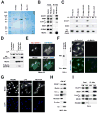
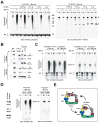
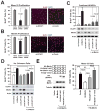

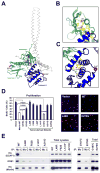
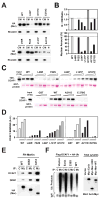

Similar articles
-
Merlin/NF2 functions upstream of the nuclear E3 ubiquitin ligase CRL4DCAF1 to suppress oncogenic gene expression.Sci Signal. 2011 Aug 23;4(188):pt6. doi: 10.1126/scisignal.2002314. Sci Signal. 2011. PMID: 21878678
-
Merlin's tumor suppression linked to inhibition of the E3 ubiquitin ligase CRL4 (DCAF1).Cell Cycle. 2010 Nov 15;9(22):4433-6. doi: 10.4161/cc.9.22.13838. Epub 2010 Nov 15. Cell Cycle. 2010. PMID: 21084862 Free PMC article.
-
Molecular insights into NF2/Merlin tumor suppressor function.FEBS Lett. 2014 Aug 19;588(16):2743-52. doi: 10.1016/j.febslet.2014.04.001. Epub 2014 Apr 12. FEBS Lett. 2014. PMID: 24726726 Free PMC article. Review.
-
Merlin/NF2 loss-driven tumorigenesis linked to CRL4(DCAF1)-mediated inhibition of the hippo pathway kinases Lats1 and 2 in the nucleus.Cancer Cell. 2014 Jul 14;26(1):48-60. doi: 10.1016/j.ccr.2014.05.001. Cancer Cell. 2014. PMID: 25026211 Free PMC article.
-
Merlin, a multi-suppressor from cell membrane to the nucleus.FEBS Lett. 2012 May 21;586(10):1403-8. doi: 10.1016/j.febslet.2012.03.016. Epub 2012 Mar 21. FEBS Lett. 2012. PMID: 22595235 Review.
Cited by
-
Gene expression, signal transduction pathways and functional networks associated with growth of sporadic vestibular schwannomas.J Neurooncol. 2017 Jan;131(2):283-292. doi: 10.1007/s11060-016-2292-9. Epub 2016 Oct 17. J Neurooncol. 2017. PMID: 27752882
-
Netrin-4 promotes glioblastoma cell proliferation through integrin β4 signaling.Neoplasia. 2012 Mar;14(3):219-27. doi: 10.1593/neo.111396. Neoplasia. 2012. PMID: 22496621 Free PMC article.
-
Transcriptional regulation of serine/threonine protein kinase (AKT) genes by glioma-associated oncogene homolog 1.J Biol Chem. 2013 May 24;288(21):15390-401. doi: 10.1074/jbc.M112.425249. Epub 2013 Apr 10. J Biol Chem. 2013. PMID: 23580656 Free PMC article.
-
Hippo/YAP pathway for targeted therapy.Transl Lung Cancer Res. 2014 Apr;3(2):75-83. doi: 10.3978/j.issn.2218-6751.2014.02.03. Transl Lung Cancer Res. 2014. PMID: 25806284 Free PMC article. Review.
-
The Emerging Role of TRAF7 in Tumor Development.J Cell Physiol. 2017 Jun;232(6):1233-1238. doi: 10.1002/jcp.25676. Epub 2017 Jan 6. J Cell Physiol. 2017. PMID: 27808423 Free PMC article. Review.
References
-
- Ahronowitz I, Xin W, Kiely R, Sims K, MacCollin M, Nunes FP. Mutational spectrum of the NF2 gene: a meta-analysis of 12 years of research and diagnostic laboratory findings. Hum Mutat. 2007;28:1–12. - PubMed
-
- Ammoun S, Flaiz C, Ristic N, Schuldt J, Hanemann CO. Dissecting and targeting the growth factor-dependent and growth factor-independent extracellular signal-regulated kinase pathway in human schwannoma. Cancer Res. 2008;68:5236–5245. - PubMed
-
- Bretscher A, Edwards K, Fehon RG. ERM proteins and merlin: integrators at the cell cortex. Nat Rev Mol Cell Biol. 2002;3:586–599. - PubMed
-
- Cho E, Feng Y, Rauskolb C, Maitra S, Fehon R, Irvine KD. Delineation of a Fat tumor suppressor pathway. Nat Genet. 2006;38:1142–1150. - PubMed
-
- Clevers H. Wnt/beta-catenin signaling in development and disease. Cell. 2006;127:469–480. - PubMed
Publication types
MeSH terms
Substances
Associated data
- Actions
Grants and funding
LinkOut - more resources
Full Text Sources
Other Literature Sources
Medical
Molecular Biology Databases
Research Materials
Miscellaneous

